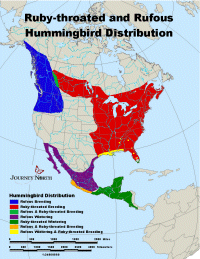| Please
Report Your Sightings! |
FINAL: Still Seeing Hummingbirds? Let Us Know!
|
|
How long will hummingbirds continue to be seen in the north? The map is finally showing a pattern of fewer reports. Surprisingly, a sighting came from North Vancouver, BC, on Oct. 27, and a male Rubythroat was still in Cedar Rapids, Iowa on November 1! You can read all of the observations here.
Hummers Weather Superstorm Sandy
As Hurricane Sandy pummeled the Eastern U.S. this week, observers in Pennsylvania, Virginia and North Carolina reported hummingbirds that weathered the storm. This photo shows a hardy hummer feeding in Lancaster, Pennsylvania. What do you notice?
| Images of the Week |
 |
| Weathering Sandy |
Home Sweet Home!
On October 23, Patricia Nethercote reported the first sighting of a male Ruby-throated Hummingbird at her farm, our "Hummingbird Observation Post" in Costa Rica. This week, she happily reports seeing a female on October 30. Which one is in this photo?
Choosing a Route
Hummers heading south of the U.S. border for winter have two choices: Cross the Gulf of Mexico, or follow a route along the coast of Texas on their way back to Mexico. Some scientists believe that fewer Ruby-throats cross the Gulf in fall than in spring. Why do you think a hummer would choose the coast route? The over-water route?
Summer Home, Winter Home: Compare Landmass
Every fall, approximately 350 of the 660 bird species that breed in North America migrate south of the U.S. border for the winter. By migration's end, the hummingbirds have funneled into a relatively small region for the winter, as this map shows. That's a big reason why conservation of winter habitat is so very important. Migratory species need good habitat all along the migration trail. Maybe one of Patricia's hummingbirds visited your feeder during the breeding season— or during migration. Thank you for protecting the habitat these hummingbirds needed along their journey.

It's time to say thank you, citizen scientists one and all, for helping to track the hummingbirds' southward migration and overwintering story. Your photos and comments really tell the story, and we are grateful and enriched by your participation. The map shows over 6,000 sightings!
Please join us again on February 6, 2013. We'll begin with preparations for spring migration and celebrating the return of the hummingbirds!





